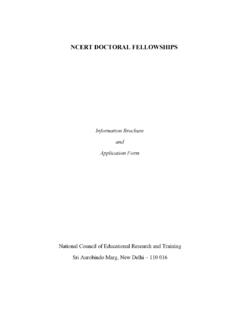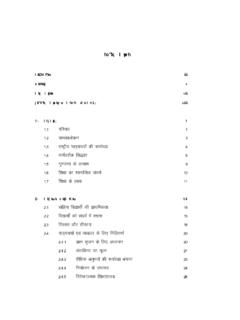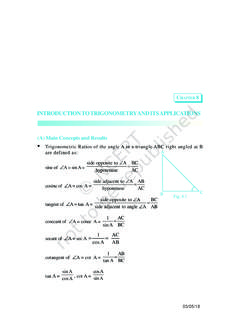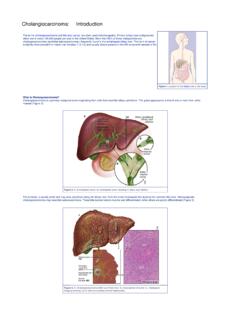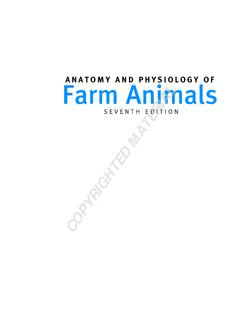Transcription of UNIT 2 - NCERT
1 UNIT 2. STRUCTURAL ORGANISATION. IN PLANTS AND ANIMALS. Chapter 5 The description of the diverse forms of life on earth was made only by morphology of observation through naked eyes or later through magnifying lenses Flowering Plants and microscopes. This description is mainly of gross structural features, both external and internal. In addition, observable and perceivable Chapter 6 living phenomena were also recorded as part of this description. Before Anatomy of Flowering experimental biology or more specifically, physiology, was established Plants as a part of biology, naturalists described only biology. Hence, biology remained as a natural history for a long time. The description, by itself, Chapter 7 was amazing in terms of detail. While the initial reaction of a student Structural Organisation in could be boredom, one should keep in mind that the detailed description, Animals was utilised in the later day reductionist biology where living processes drew more attention from scientists than the description of life forms and their structure.
2 Hence, this description became meaningful and helpful in framing research questions in physiology or evolutionary biology. In the following chapters of this unit, the structural organisation of plants and animals, including the structural basis of physiologial or behavioural phenomena, is described. For convenience, this description of morphological and anatomical features is presented separately for plants and animals. 2015-16(19/01/2015). KATHERINE ESAU was born in Ukraine in 1898. She studied agriculture in Russia and Germany and received her doctorate in 1931 in United States. She reported in her early publications that the curly top virus spreads through a plant via the food- conducting or phloem tissue. Dr Esau's Plant Anatomy published in 1954 took a dynamic, developmental approach designed to enhance one's understanding of plant structure and an enormous impact worldwide, literally bringing about a revival of the discipline.
3 The Anatomy of Seed Plants by Katherine Esau was published in 1960. It was referred to as Webster's of plant biology it is encyclopediac. In 1957 she was elected to the National Academy of Sciences, becoming the sixth woman to receive that honour. In addition to this prestigious award, she received the National Medal of Science from President George Bush in 1989. When Katherine Esau died in the year 1997, Peter Raven, director of Anatomy and morphology , Missouri Botanical Garden, remembered that she absolutely dominated' the field Katherine Esau of plant biology even at the age of 99. (1898 1997). 2015-16(19/01/2015). CHAPTER 5. morphology OF FLOWERING PLANTS. The Root The wide range in the structure of higher plants will never fail to fascinate us. Even though the angiosperms show such a large diversity in external The Stem structure or morphology , they are all characterised by presence of roots, The Leaf stems, leaves, flowers and fruits.
4 The Inflorescence In chapters 2 and 3, we talked about classification of plants based on morphological and other characteristics. For any successful attempt The Flower at classification and at understanding any higher plant (or for that The Fruit matter any living organism) we need to know standard technical terms and standard definitions. We also need to know about the possible The Seed variations in different parts, found as adaptations of the plants to their Semi-technical environment, , adaptions to various habitats, for protection, Description of a climbing, storage, etc. Typical If you pull out any weed you will see that all of them have roots, stems Flowering Plant and leaves. They may be bearing flowers and fruits. The underground Description of part of the flowering plant is the root system while the portion above the Some Important ground forms the shoot system (Figure ).
5 Families THE ROOT. In majority of the dicotyledonous plants, the direct elongation of the radicle leads to the formation of primary root which grows inside the soil. It bears lateral roots of several orders that are referred to as secondary, tertiary, etc. roots. The primary roots and its branches constitute the 2015-16(19/01/2015). 66 BIOLOGY. tap root system, as seen in the mustard Flower plant (Figure ). In monocotyledonous plants, the primary root is short lived and is replaced by a large number of roots. Fruit These roots originate from the base of the Stem stem and constitute the fibrous root Leaf Shoot system, as seen in the wheat plant (Figure system ). In some plants, like grass, Monstera and the banyan tree, roots arise Node from parts of the plant other than the Internode { Bud radicle and are called adventitious roots (Figure ).}
6 The main functions of the root system are absorption of water and minerals from the soil, providing a proper Primary anchorage to the plant parts, storing root Root reserve food material and synthesis of Secondary system plant growth regulators. root Figure Parts of a flowering plant Main root Laterals Fibrous roots Adventitious roots (a) (b) (c). Figure Different types of roots : (a) Tap (b) Fibrous (c) Adventitious 2015-16(19/01/2015). morphology OF FLOWERING PLANTS 67. Regions of the Root The root is covered at the apex by a thimble-like structure called the root cap (Figure ). It protects the tender apex of the root as it makes its way through the soil. A few millimetres above the root cap is the region of meristematic activity. The cells of this region are very small, thin-walled and with dense protoplasm.
7 They divide repeatedly. The cells proximal to this region undergo rapid elongation and enlargement and are responsible for the growth of the root in length. This region is called the region of elongation. The cells of the elongation zone gradually differentiate and mature. Hence, this zone, proximal to region of elongation, is called the region of maturation. From this region some of the epidermal cells form very fine Figure The regions of the root-tip and delicate, thread-like structures called root hairs. These root hairs absorb water and minerals from the soil. Modifications of Root Roots in some plants change their shape and structure and become modified to perform functions other than absorption and conduction of water and minerals. They are modified for support, storage of food and respiration (Figure and ).
8 Tap roots of carrot, turnip and adventitious roots of sweet potato, get swollen and store food. Can you give some more such examples? Have you ever wondered what those hanging structures that support a banyan tree are? These are called prop roots. Similarly, the stems of maize and sugarcane have supporting roots coming out of the lower nodes of the stem. These are called stilt roots. In some plants such as Rhizophora growing in swampy areas, many roots come out of the ground and grow vertically upwards. Such roots, called pneumatophores, help to Figure Modification of root for support: get oxygen for respiration. Banyan tree 2015-16(19/01/2015). 68 BIOLOGY. Turnip Carrot Sweet potato Asparagus (a) (b). Figure Modification of root for : (a) storage (b) respiration: pneumatophore in Rhizophora THE STEM.
9 What are the features that distinguish a stem from a root? The stem is the ascending part of the axis bearing branches , leaves, flowers and fruits. It develops from the plumule of the embryo of a germinating seed. The stem bears nodes and internodes. The region of the stem where leaves are born are called nodes while internodes are the portions between two nodes. The stem bears buds, which may be terminal or axillary. Stem is generally green when young and later often become woody and dark brown. The main function of the stem is spreading out branches bearing leaves, flowers and fruits. It conducts water, minerals and photosynthates. Some stems perform the function of storage of food, support, protection and of vegetative propagation. Modifications of Stem The stem may not always be typically like what they are expected to be.
10 They are modified to perform different functions (Figure ). Underground stems of potato, ginger, turmeric, zaminkand, Colocasia are modified to store food in them. They also act as organs of perennation to tide over conditions unfavourable for growth. Stem tendrils which develop from axillary buds, are slender and spirally coiled and help plants to climb such as in gourds (cucumber, pumpkins, watermelon) and grapevines. Axillary buds of stems may also get modified into woody, straight and pointed thorns. Thorns are found in many plants such as Citrus, Bougainvillea. They protect plants from browsing animals. Some plants of arid regions modify their stems into flattened (Opuntia), or fleshy cylindrical (Euphorbia) structures. They contain chlorophyll and carry 2015-16(19/01/2015). morphology OF FLOWERING PLANTS 69.


